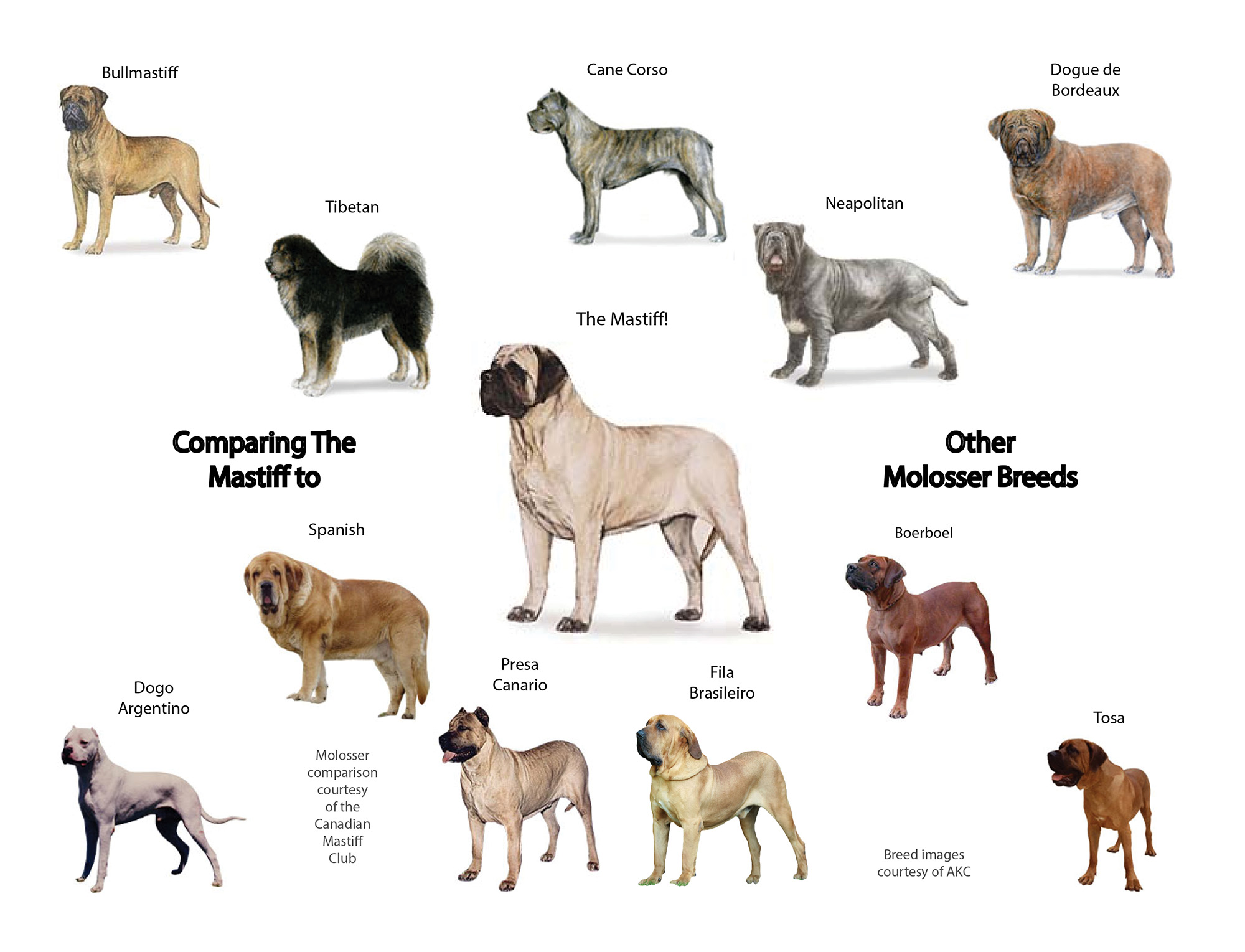Canadian Mastiff Club
Identifying Molosser Breeds
Mastiffs, Molossers and Misunderstanding!
There are many different mastiff breeds but only one true Mastiff which also belongs to a group of dogs called Molossers. The Mastiff is sometimes referred to as the English Mastiff or Old English Mastiff but the official name of the breed is Mastiff.
The term Molosser describes a group of working dogs with a related ancestry that were used historically to guard and protect properties and livestock. Molossers include breeds such as the Boxer, Bull Terrier, Cane Corso, Dogue de Bordeaux, Fila Brasileiro, Great Dane, Great Pyrenees, Mastiff, Newfoundland, Neopolitan Mastiff, Shar Pei and Tibetan Mastiff, among other breeds. Typically, Molossers can be identified by a comparatively large head, shortened muzzle, heavy bone and often thick and wrinkled skin. Many of the numerous Molosser breeds are often referred to as a “mastiff” which is confusing and misleading. The different Molosser breeds were developed for different purposes and therefore have many physical and temperamental differences between them.
Blame or praise can be unfairly associated with the Mastiff breed due to a failure to correctly identify Molosser dogs and can thereby paint a misleading picture of the Mastiff breed as well as the other Molosser breeds. By referring to each distinct breed by their correct breed name we can help to lessen misunderstanding and misidentifications. Anyone looking for a Molosser breed of dog should be aware of the differences between the breeds and investigate which would be the best fit for them and their family based on activity level, trainability, temperament and specific breed traits.
To help identify the most common Molosser breeds please refer to the handy image and chart below.

|
Official Breed Name |
Also known as: |
Physical Characteristics |
|
Mastiff |
English Mastiff |
Fawn, apricot and brindle coats with black mask on the face & on ears. Largest mastiff breed with the most physical substance of all the mastiff breeds. Weight can range from 130 to 230+ lbs. |
|
Bullmastiff |
|
Brindle, fawn and red coats with black mask on the face. Much shorter muzzle compared to the Mastiff. Average weight 100 to 130 lbs. |
|
Cane Corso |
Italian Mastiff |
Black, blue, fawn and red or any of these colors in brindled coats. Well-muscled and athletic, usually have cropped ears and docked tails. Average weight 84 to 110 lbs. |
|
Dogue de Bordeaux |
French Mastiff |
Mahogany (red-brown), fawn or golden colored coats. Light eyes and nose to match coat color. Some dogs may have black mask. Average weight is 120 lbs. |
|
Neopolitan Mastiff |
Neo, Mastino |
Grey, black, mahogany or tawny coat colors, either solid or brindled. Heavy bone & thick wrinkled skin. Often have cropped ears and sometimes partially docked tails. Average weight 110 to 150 lbs. |
|
Tibetan Mastiff |
Do-Khyi |
Very full & thick double coat with black, black-and-tan or golden colors. Average weight 100 to 160 lbs. |
|
Fila Brasileiro |
Brazilian Mastiff |
*Not a recognized breed in Canada. Black, fawn, apricot & brindle coat colors. Longer muzzle & long ears. Stance with rear higher than shoulders. Average weight 90 to 130 lbs. |
|
Boerboel |
South African Mastiff |
*Not a recognized breed in Canada. Mahogany, red, fawn, brindle, cream, brown and piebald coat colors. Sometimes the tail is docked. Average weight 110 to 175 lbs. |
|
Dogo Argentino |
Argentinian Mastiff |
*Not a recognized breed in Canada. Always pure white coat color. Athletic. Ears are usually cropped. Average weight 75 to 100 lbs. |
|
Presa Canario |
Canary Island Mastiff |
*Not a recognized breed in Canada. Seen with all shades of fawn or brindle coats. Ears are usually cropped. Average weight 85 to 130 lbs. |
|
Spanish Mastiff |
Mastin Espanol |
*Not a recognized breed in Canada. Fawn, brindle, black or “wolf” colored coats. Very loose skin on throat. Average weight 130 to 220 lbs. |
|
Tosa |
Tosa Inu, Japanese Mastiff |
*Not a recognized breed in Canada. Black, brindle, fawn and red coat colors. Average weight 80 to 135 lbs. |
* The Canadian Kennel Club (CKC) does not recognize this breed as purebred in Canada. Any breeds that are unrecognized are ineligible for registration with the CKC. The CKC registries exist to promote and advance the purebred dog. They approve breed standards, maintain birth records of registered dogs, promote responsible dog ownership, maintain official records for these events, and award titles.
To learn more about the specific characteristics of the Mastiff, please visit Breed Characteristics.
